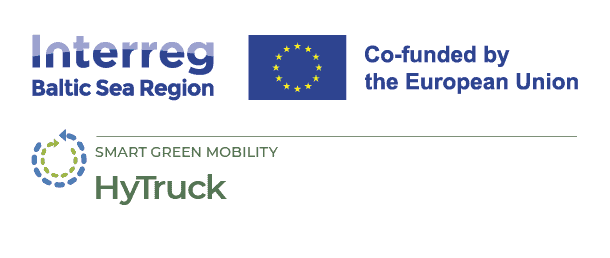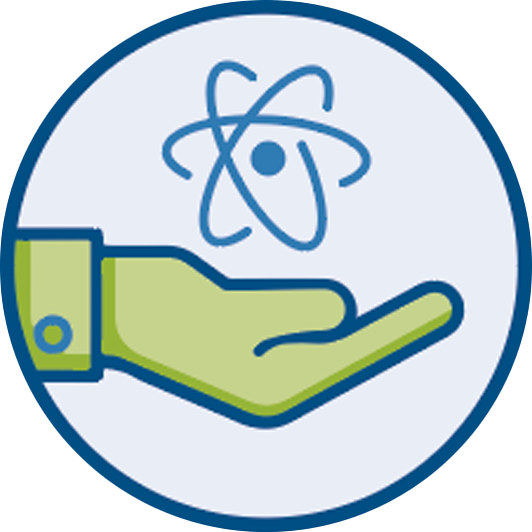
Final breakfast briefing: Presenting HyTruck tools, pilots and main findings
20 October 2025
Project Overview, Objectives & Structure
Katrin Bockler (Ministry of Economics, Infrastructure, Tourism and Labour Mecklenburg-Vorpommern) provided a comprehensive overview of the HyTruck project, its objectives, and structure. The project’s main goal is to enable clean road freight transport in the Baltic Sea region by creating a transnational network of green hydrogen refueling stations (HRS) for trucks. The project aims to support public authorities in steering the development of an HRS network with harmonized standards across borders, addressing the “chicken and egg” problem of low HRS demand and supply.
Challenges Identified:
- Market ramp-up for hydrogen economy
- Need for streamlined technology and infrastructure providers
- Engagement of customers and public administration
- Uncertainty in fuel prices and technological standards
- Spatial complexity and need for transnational collaboration
Regulatory Context:
- AFIR Regulation (April 2024): Mandates HRS construction along TEN-T corridors, with technical requirements (e.g., 700 bar pressure, 1 ton/day capacity, max 200 km between stations).
Project Structure:
- Work Package 1: Framework and planning tools (location, economy, technology, safety)
- Work Package 2: Piloting and evaluating solutions (five pilot studies)
- Work Package 3: Transferring solutions and communication (community building, transnational concept, funding, and policy programs)
Thematic Presentations – Tools, Solutions, and Technical Insights
Spatial Planning Toolkit – University of Tartu (Alexander Kmoch)
Alexander presented a web-based spatial planning toolkit for HRS location suitability. The tool integrates academic and stakeholder-weighted criteria using a hexagonal grid for equal-area analysis. Two main weighting methods were used: literature-based (academic) and stakeholder survey-based. The toolkit allows for scenario planning, such as determining the minimum number of stations needed along corridors, and supports interactive exploration of suitability scores for different regions. The toolkit and its data will be made open source for future use.
Key Features:
- Aggregated suitability analysis for HRS locations
- Criteria include terrain, proximity to urban nodes, energy infrastructure, etc.
- Interactive web application with feedback functionality
- Open-source transition for broader accessibility
Polish Perspective – Polish New Mobility Association (Aleksander Rajch)
Aleksander emphasized Poland’s unique energy challenges and the strategic importance of the Wielkopolski region for HRS deployment. Poland wastes significant renewable energy due to grid inflexibility, making hydrogen crucial for both mobility and energy storage. The region was chosen for its population, location, and renewable hydrogen production potential. Recommendations included comprehensive planning, leveraging existing infrastructure, integrating future technologies, and addressing safety and scalability. The catalogue of technical standards was highlighted as essential for harmonization.
Key Points:
- Importance of hydrogen for Poland’s energy and mobility sectors
- Strategic location and industrial partners in Wielkopolski region
- Need for scalable, safe, and future-proof HRS infrastructure
- Integration with existing petroleum stations and logistics corridors
- Technical standards catalog (over 30 standards) for harmonization
Swedish Technological Pathways – Chalmers University (Jorge Velandia Vargas)
Jorge analyzed hydrogen supply chain options for Sweden, comparing grid electrolysis, green hydrogen, steam reforming, and imports. The study evaluated different technological pathways for hydrogen production and delivery, considering environmental and economic impacts.
Key Findings:
- On-site hydrogen production is most competitive
- Fuel cell trucks outperform internal combustion engines environmentally
- Liquid hydrogen transport is promising but technically challenging (low payload, boil-off issues)
- Battery evolution is a critical factor for future competitiveness
- Importing hydrogen via tanker ships is currently inefficient
Takeaways:
- Swedish grid is highly competitive due to low carbon intensity
- Hydrogen should be used in “no regret” applications (e.g., green steel production with captive fleets)
- Long-distance gaseous hydrogen transport presents high impacts
Cost & Business Models – RISE & Chalmers (Hadi Farabi Asl)
Hadi presented cost modeling for green hydrogen production and HRS business cases. The analysis covered grid-connected, PV, and wind-based hydrogen production across pilot regions, with costs ranging from 4 to 11 €/kg (grid), 8 to 10 €/kg (PV), and variable costs for wind. Subsidies and byproduct sales (oxygen, heat) can reduce costs by 5–15%. The business model for HRS considered different pressures (350/700 bar), cascading vs. booster options, and sensitivity to electricity prices and operational load.
Key Insights:
- Cost reductions possible through subsidies and byproduct sales
- Higher pressure (700 bar) increases refueling costs
- Cascading systems better for uniform load; boosters for peak demand
- Need for detailed engineering studies for each site
HRS Guidelines – Reiner Lemoine Institute (Marcus Schober)
Marcus summarized the guidelines for building HRS in the Baltic Sea region, designed for public authorities. The guidelines are structured in three parts: introduction, concept phase (demand assessment, distribution, design, economics, GHG reduction), and planning stage (site selection, permits, network collaboration). It condenses technical findings into actionable insights for non-experts.
Key Elements:
- Introduction to hydrogen and HRS needs
- Concept phase: demand, distribution, design, economics, GHG reduction
- Planning stage: site selection, permits, technical standards, collaboration
- Available on the HyTruck website
Regional Pilot Implementations & Spatial Development Concepts
Finland (CLIC Innovation) – Oleg Todorov
Oleg detailed the regional pilot focusing on carbon neutrality and hydrogen economy. The analysis covered legal and policy frameworks, HRS network status, green hydrogen supply (wind power growth), suitability analysis, anchor customer identification, stakeholder dialogue, and neighborhood analysis (cross-border connectivity). Strategic HRS network planning is led by Vireon Hydrogen, with integration of renewable energy and cross-border collaboration.
Highlights:
- Focus on southern Finland (Helsinki region in connection with Kotka and Turku)
- First HRS recently inaugurated in Jyväskylä, collaboration between Vireon and Cefmof
- Wind power as main green energy source (7–10 GW installed)
- HRS location suitability based on AFIR requirements and anchor customers
- Stakeholder engagement: developed on regional, national and transnational levels
- Regional development: initial HRS pilots in Helsinki and Jyväskylä, expansion plans along TEN-T and urban nodes, phased approach securing financial support
Latvia (Vidzeme Planning Region) – Krista Pētersone
Krista presented location studies and policy recommendations, emphasizing the need for strategic HRS placement, financial support, and regulatory clarity. The concept of hydrogen valleys and the importance of matching infrastructure investment with vehicle deployment were highlighted.
Key Points:
- Focus on GHG emission reduction (heavy-duty transport = 1/3 of Latvia’s transport emissions)
- Pilot covers all Latvia and part of Estonia for connectivity
- Primary HRS location at major transportation intersection, approved by national policymakers
- Policy recommendations: financial support, regulatory frameworks, hydrogen valleys for EU funding
- Need for technological neutrality and functional requirements in public procurements
Lithuania (Ministry of Transport and Communications) – Andrius Ružinskas
Andrius described the spatial development concept for Kaunas and Panevėžys, focusing on location suitability, stakeholder engagement, and recommendations for legal and funding frameworks.
Highlights:
- Lithuania has no operating HRS yet; two hydrogen vehicles registered
- AFIR implementation requires 5–8 stations, depending on urban node capacity
- Kaunas and Panevėžys chosen for high traffic and logistics potential
- Spatial toolkit used to identify optimal locations (criteria: proximity to roads, grid power, customer demand)
- Stakeholder feedback: concerns about user numbers and green hydrogen supply
- Recommendations: update national legislation, explore new funding sources, continue stakeholder collaboration
Germany (Lead Partner) – Katrin Bockler & Sven Friedrich
Katrin analyzed the Rostock region, noting strong renewable energy potential but limited HRS infrastructure. Funding challenges and the need for targeted federal policy were discussed. The transnational spatial development concept aims to ensure a continuous HRS network along the TEN-T corridor.
Key Points:
- Rostock: largest harbor in the region, high renewable energy potential
- Only one HRS is currently in operation; more planned but funding is uncertain
- Stakeholder workshops engaged producers, truck operators, regional players
- Funding model from the Netherlands (linking vehicle and HRS support) suggested for Germany
- Need for targeted federal policy to support ramp-up
- Transnational concept: mapping current/planned HRS, identifying gaps, proposing additional locations
Transnational Concept & Next Steps (Lead Partner) – Sven Friedrich
Sven presented the transnational spatial development concept, which synthesizes findings from pilot regions and maps the current and planned HRS network along the TEN-T corridor. The analysis identifies green, yellow, and red segments based on compliance with AFIR distance requirements. Planned stations will improve coverage, but gaps remain, especially in urban nodes. Partner recommendations and ongoing projects aim to close these gaps. The final report and maps will be presented at the upcoming Helsinki conference.
Key Takeaways:
- Continuous HRS network from Narvik to Berlin is the goal
- Assessment of existing, planned, and recommended stations
- Urban node coverage still incomplete; further planning needed
- Final report and maps to be published and presented at Helsinki conference
Closing Remarks & Future Outlook
The session concluded with appreciation for the consortium’s work, reminder about the HyTruck final conference in Helsinki (November 12) and reference to the HyTruck website and LinkedIn page for more information.
It was concluded that HyTruck has built a solid foundation for a transnational hydrogen refueling network in the Baltic Sea region, addressing technical, regulatory, and market challenges. Collaboration among public authorities, industry, and academia is essential for harmonized standards and effective deployment. Strategic planning, stakeholder engagement, and targeted funding are critical for scaling up HRS infrastructure and meeting EU regulatory requirements.





